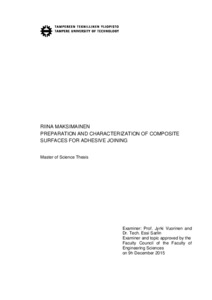Preparation and characterization of composite surfaces for adhesive joining
Maksimainen, Riina Elina (2016)
Maksimainen, Riina Elina
2016
Materiaalitekniikan koulutusohjelma
Teknisten tieteiden tiedekunta - Faculty of Engineering Sciences
This publication is copyrighted. You may download, display and print it for Your own personal use. Commercial use is prohibited.
Hyväksymispäivämäärä
2016-02-03
Julkaisun pysyvä osoite on
https://urn.fi/URN:NBN:fi:tty-201601221028
https://urn.fi/URN:NBN:fi:tty-201601221028
Tiivistelmä
Composites are widely used in large industrial tanks and vessels due to their excellent mechanical and chemical durability. Large tanks and vessels are typically assembled from multiple parts, thus joints are unavoidable. The goal of this thesis is to determine the optimal surface treatments for adhesive joining, and an on-site inspection method to verify the surface characteristics.
This thesis is divided in theoretical and experimental parts. The theoretical part concentrates on design, pretreatments, manufacture and inspection of adhesive composite joints. The effect of moisture, sulphuric acid and temperature on joint durability is discussed as well. The experimental part is divided into two parts. In the first part the formation and removal of air-inhibited layer is studied. Four different vinyl-ester epoxy resins were cured and the surfaces were measured with Fourier transform infrared spectroscopy (FT-IR) before and after abrading. The second part consists of different characterization methods of six mechanically pretreated filament wound laminates. The aim is to determine the best surface for adhesive joining, and determine an on-site inspection method for the pretreated surface. The surface energy of the laminates is measured with contact angle measurement, and the surface roughness is measured with a stylus system and optical 3D profilometer. The surfaces are also analyzed with FT-IR and scanning electron microscope (SEM). Lastly, mechanical pull-off adhesion tests are performed. The test series was carried out as blind test; the pretreating methods were revealed after the characterization and analysis was done.
It was discovered that the thickness of the air-inhibited layer is less than 3 mm, and even light mechanical pretreatments removed the layer, thus its formation is not concerning. In the surface treatment methods sandblasting stood out. However, it is important to choose the sandblasting parameters right; negligent sandblasting or too fine sand do no result in adequate surface for adhesive joining. To verify the roughness of a sandblasted surface on-site, a stylus system can be used when the limit values are outlined. To verify these results, more mechanical testing (e.g. single lap shear tests) should be carried out.
This thesis is divided in theoretical and experimental parts. The theoretical part concentrates on design, pretreatments, manufacture and inspection of adhesive composite joints. The effect of moisture, sulphuric acid and temperature on joint durability is discussed as well. The experimental part is divided into two parts. In the first part the formation and removal of air-inhibited layer is studied. Four different vinyl-ester epoxy resins were cured and the surfaces were measured with Fourier transform infrared spectroscopy (FT-IR) before and after abrading. The second part consists of different characterization methods of six mechanically pretreated filament wound laminates. The aim is to determine the best surface for adhesive joining, and determine an on-site inspection method for the pretreated surface. The surface energy of the laminates is measured with contact angle measurement, and the surface roughness is measured with a stylus system and optical 3D profilometer. The surfaces are also analyzed with FT-IR and scanning electron microscope (SEM). Lastly, mechanical pull-off adhesion tests are performed. The test series was carried out as blind test; the pretreating methods were revealed after the characterization and analysis was done.
It was discovered that the thickness of the air-inhibited layer is less than 3 mm, and even light mechanical pretreatments removed the layer, thus its formation is not concerning. In the surface treatment methods sandblasting stood out. However, it is important to choose the sandblasting parameters right; negligent sandblasting or too fine sand do no result in adequate surface for adhesive joining. To verify the roughness of a sandblasted surface on-site, a stylus system can be used when the limit values are outlined. To verify these results, more mechanical testing (e.g. single lap shear tests) should be carried out.
